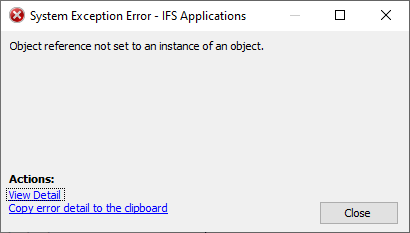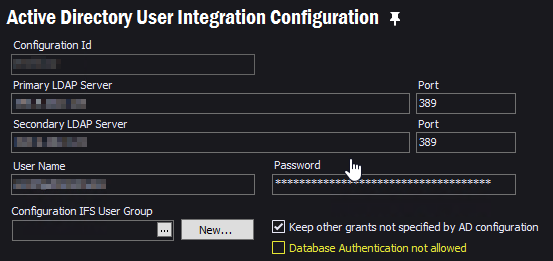Hi all,
I have configured SSO according to:
- /ifsdoc/f1doc/foundation1/040_administration/210_security/015_authentication/030_configure_ADFS/default.htm
- /ifsdoc/f1doc/foundation1/040_administration/210_security/010_users/100_active_directory_sync/default.htm
- /ifsdoc/f1doc/foundation1/040_administration/210_security/015_authentication/060_SSO_behaviour/default.htm
...and also configured ADFS on Windows 2016 (successfully logging on using Chrome, IE11 and Edge). But when I try to log on using SSO, I see error “Object reference not set to an instance of an object”.
Full error details are:
Ifs.Fnd.FndSystemException: Unexpected error while calling server method AccessPlsql/Invoke
at Ifs.Fnd.AccessProvider.FndConnection.InvokeInternal(Object requestBody, Object responseBody, String intface, String operation, FndRequestContext requestContext, FndManualDecisionCollection decisions, Boolean forcedSync, Boolean integrationGateway)
at Ifs.Fnd.AccessProvider.FndConnection.InvokeInternal(String intface, String operation, Object requestBody, Object responseBody, FndRequestContext requestContext, Boolean forcedSync, Boolean integrationGateway)
at Ifs.Fnd.AccessProvider.PLSQL.FndPLSQLCommandCollection.Invoke()
at Ifs.Fnd.AccessProvider.PLSQL.FndPLSQLCommand.ExecuteNonQuery()
at Ifs.Fnd.AccessProvider.PLSQL.FndPLSQLSelectCommand.ExecuteReader(String recordType, Int32 fetchsize)
at Ifs.Fnd.AccessProvider.PLSQL.FndPLSQLSelectCommand.ExecuteReader()
at Ifs.Fnd.AccessProvider.Interactive.FndLoginDialog.checkLanguage(FndLoginCredentials loginCreds)
at Ifs.Fnd.AccessProvider.Interactive.FndLoginDialog.AuthenticateCredentials(FndLoginCredentials loginCreds) ---> System.NullReferenceException: Object reference not set to an instance of an object.
at Ifs.Fnd.AccessProvider.FndConnection.CallGetResponse(String intface, String operation, FndRequestContext requestContext, FndManualDecisionCollection decisions, Byte[] requestHeaderBytes, Byte[] requestBodyBytes, FndApfAsyncInvoke asyncInvokeHandle, Boolean integrationGateway)
at Ifs.Fnd.AccessProvider.FndConnection.InvokeGetResponse(String intface, String operation, FndRequestContext requestContext, FndManualDecisionCollection decisions, Byte[] requestHeaderBytes, Byte[] requestBodyBytes, Boolean& abandoned, Boolean forcedSync, Boolean integrationGateway)
at Ifs.Fnd.AccessProvider.FndConnection.InvokeInternal(Object requestBody, Object responseBody, String intface, String operation, FndRequestContext requestContext, FndManualDecisionCollection decisions, Boolean forcedSync, Boolean integrationGateway)
--- End of inner exception stack trace ---
I can’t find any specific instructions as to whether “Database Authentication not allowed” should be checked in Active Directory User Integration Configuration…?
What am I missing??
Thanks,
Ged.







